 |
Putoline Oil is an important player in the market for motorcycle lubricants and maintenance products |
Full Engine Re-Build continued.

The "Xmas" tree gearcluster, separate gears, shims and bearings are now going to be fitted to make up the gearbox

Just near the selector arm, in the casing is a housing for the bottom Xmas tree gear cluster, in here goes the needle roller bearing.
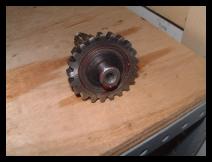
On the bottom of the cluster is fitted a shim, the bottom is the widest part.
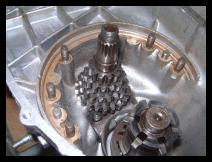
First into the casing goes the cluster, making sure the shim is still in position when fitted, simply pop the cluster into the needle roller,
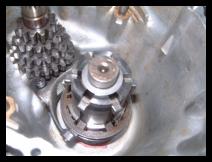
On the top of the mainshaft, fit the top shim, it fits as in the picture just lay it on.

Next pop on the end plate roller bearing for the mainshaft, again just pop it in position
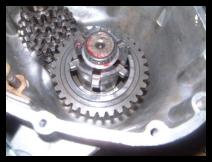
The first gear to go in is forth, this is the smallest gear of all. If you look at the gears carefully, second third and forth have a boss on them, a slightly raised part on one side. This is important as they go in a certain way. Forth gear fits with its highest boss towards you.
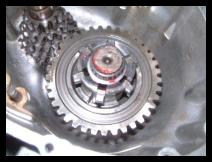
After you are happy with forth gear being put in, make sure that forth is level with its counter part gear on the cluster. Next in is third, again check the highest boss, this time the boss faces towards the rear hub. Again check and make sure the gears line up. If they do not, try another sized shim at this under the cluster at this stage
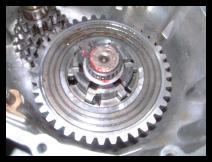
Second gear now goes in, the same way round as third gear, the highest boss faces in towards the rear hub. Again check the alignment as you go.
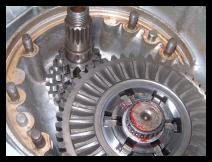
Notice first gear, you will see on the top face some teeth, these are for the kick-start to mate to when starting, again only fit this way round!
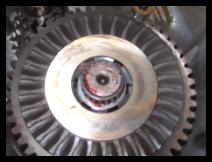
Fit the mainshaft shim now, if you are using a totally new gearbox, I would suggest a few shims, 2.0 2.2 & 2.4 should be fine. If you are using your original gearbox and casing, you should be OK with your old shim. If you are using new, fit the 2.2 first and them when can measure up.
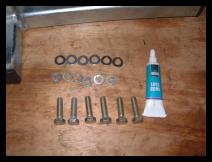
Instead of the original stud and nut, we have used high tensile steel bolts too secure the endplate. Make sure you get these from a Lambretta dealer as they need to be the correct length. Loctite is also used here to secure these bolts. This method is simpler and quicker. If you are using the original stud method, it is important you take the studs out, check all threads and clean them thourghly. Make sure when refitting the studs they are put in tight, make use of locktite thread lock. Use the correct nuts and spring washers preferabley supplied by a Lambretta dealer as they will be the correct lenght, and more importantly for the washers, be high tensile.
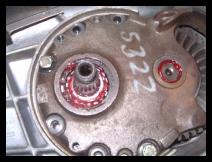
Remember the picture above and the shim, we will need it to check endplate float later on. With the new bearing fitted into the endplate, it is held in there by a circlip, fit the end plate, making sure if goes on nice and square. You will need to wiggle it to get the two shafts and bearings, plus all the studs and dowels to line up. Do all the nuts up at and even rate to pull the end plate down evenly, continue until tight.
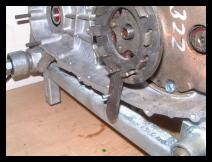
Fit the outer part of the clutch housing, the spider only at this stage, we need to check every thing is tight and secure for measuring the endplate float. Fit the clutch holding tool to secure the mainshaft so it will not turn and into this just place the clutch spider on its splines,

Again when we fitted the brakes, make sure that either you have a spacer or the rear hub fitted and torque to 120lbs so we can start measuring.
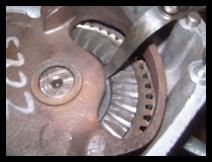
Now we are ready to measure end plate float. This is done by measuring the gap between the shim on first gear to the inner face of the end plate. The gap we are looking for is between 0.07mm to 0.30mm, the use of thicker or thinner shims adjusts this gap.

Now when you are happy with gearbox operation you can continue to fit the rest of the end plate nuts or bolts. Secure evenly and nice and tight.

Fit the mainshaft shim washer, the Home Workshop Manual mentions that these shims align the chain, true they do, but unless you have the correct workshop tool for doing this don't worry as if you try to alter the measurements and you get it wrong, you will do more damage then good.
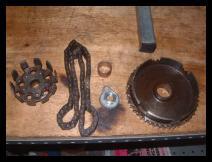
Parts needed to fit the chain, rear sprocket, chain and guides, clutch housing bush or bearing, and the clutch nut and tab washer
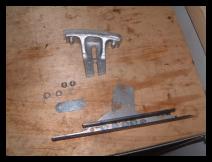
The chain guides, there are now many types of new top chain adjusters available, certainly on any tuned Lambretta, but even for the cost of them they are a good idea to use instead of the factory "normal" type. a) they last longer & b) these types are much less prone to breakage's, hence aiding reliability.
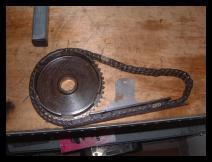
Slip the chain around the rear sprocket, your front one will already have been fitted
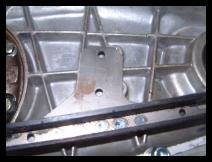
Roughly position the bottom chain guide in place (and the top one if you are using the original style), lay the chain around the front sprocket with one hand while holding the rear sprocket with the chain around it in the other.
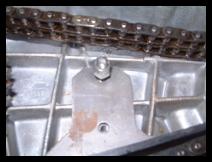
On some types of chain tensioner a stud is used to fix the guides, secure the bottom one first which does not mover, then the top over that.
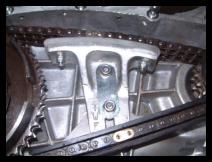
The top tensioner, is used to take up the slack in the chain, ideally your chain will not require too much adjustment, but to get the correct adjustment, push upwards on the adjuster to tension the chain. Nip the bolts up, then between the front sprocket and the tensioner, wiggle the chain up and down, you should have 1/2" play at most. Tighten fully the tensioner when you are happy with this.

If you have a look at this rear sprocket you will see it is solid. There are some that have a rivet section in them, these are two piece rear sprockets. Again for tuned and ideally all scooters, a solid non riveted type should be used. The rivets are not uncommon in breaking or allowing the two sections to come apart. Fit your centre bush or bearings now, either two needle roller bearings or one brass bush, some prefer the brass type of bush.

Bath your clutch corks in the ST90 gearbox oil you will use, if you fit them dry without soaking them first, you run the risk of burning the plates out from the word go!

Fit the clutch spider into the rear sprocket, in just goes in on the bearings/bush. Notice the legs of the spider, the top edge is like a castle effect, then after this the shafts of the spider should be smooth, if yours has ruts or lumps it is worn, either file flat again or replace.

A tab washer locates on any one of the pins with it's eyelet, the clutch nut can then be tightened down by hand.

Fit the clutch holding tool, do not try to use screwdrivers or anything else to trap or jam this, damage will occur, these tools are very cheap and very necessary.

Using the best socket and ratchet you have, simply get this nut as tight as you can, there is no torque setting other than really tight! Use a screwdriver and hammer to knock over one edge of the tab washer onto the nut, this is done to stop the nut coming un done.

The clutch springs, and here we are using a centre spring as well due to the tuned engine. When checking your clutch springs, you should stand all five up, they need to be all the same height. You can buy many different springs, from lenghts to strengh, check with your supplier as many suppliers have differing options.

To stop the springs from falling, especially if the engine is still in the scooter, simply dab one end of the spring in grease before fitting.

By dabbing the grease on one end of the spring, this can now be placed in its recess in the clutch spider, it will help to keep the spring in position

Carry on until all five are in place

Fit the clutch basket, again it has recess in it for the springs to sit in, plus the legs of the basket will need to align with the legs of the clutch spider. Onto this goes a clutch cork

After the first cork, put a steel plate on this, then cork etc

Carry on until the last part which is the steel top plate, this has a chamfered edge on it and is thicker then the other plates. GP top plates differ to all other models by being thicker.

Now we need to use the clutch compressor to compress the clutch basket and springs.

When this is done you can slide the corks and plates down into the housing, they should slide down pretty freely with no interference.

Continue to compress so that the top plate is under the grove in the leg of the clutch spider. Now you can fit the clutch retaining circlip, where the two ends meet they should be placed so that both ends fit inside a leg.
Once the circlip is fitted, using a small thin screw driver, try to wiggle the clutch plates, there should be a small amount of play in the clutch. If the plates appear solid, or no movement can be made, chances are you need a thinner top plate. If you have a GP type, this can be swapped for a thinner Li/SX type, if you already have the thinner type, you are going to need to check through things and try to reduce the hieght of the clutch assembly. There are many ways of doing this, but it might be better to contact your parts supplier if you have used many new parts, as there can be issues with springs, basket, spider or plates when you come across this problem.

All that remains now is to fit the chain case side gasket, if you have a non GP/DL machine make sure the top clutch thimble is in position.

To assemble the kick-start mechanism, the shaft requires a bottom plate, a spring then the kick-start piston. In the side is a hole for the locating/locking pin. When this is assembled place the whole shaft through the chain casing. Fit the return spring, look carefully there are holes in the casing and shaft for each end to go. For GP machines only, fit the brass clutch operating bush in its housing.

Fit the clutch operating arm as shown, complete with return spring.

On the outside of the kick-start shaft fit the kick-start shim and retaining circlip.
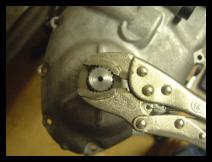
Using a set of mole grips securely fixed to the kick-start shaft, you can now place the chain case side on the engine.
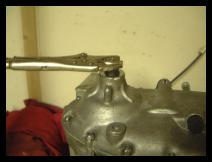
This is done so you can use the grips to align the kick-start into position, as it needs to be wound back for tension and to seat properly.
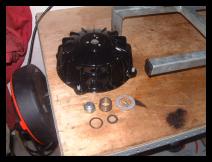
Rear hub, shims and locking kit.
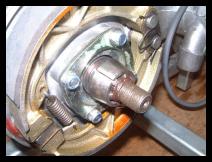
First put the thin shim washer in position, the the rear hub cone. The split on the cone should fit down the raised edge of the main shaft as shown in the picture.
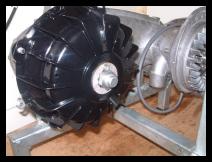
Finally fit the rear hub on its splines and affix the nut. If you engine is in the frame put the engine into first gear and ask a friend to push down on the rear brake pedal as hard as they can. If not do the same, but use some thing suitable on the rear brake arm to lock the wheel. Tighten the rear hub as hard as you possibly can. Place the locking washer over the nut, check for alignment of the hole for the grub screw. You can turn the locking plate in three different positions, if it still does not align, again locking the rear wheel as mentioned, tighten until alignment takes place. Fit the Allen key grub screw and tighten.
Here we have it, one fully rebuilt engine.

